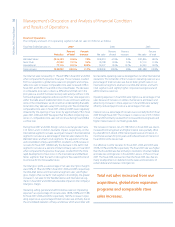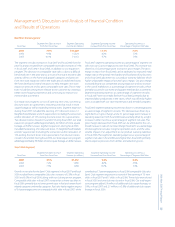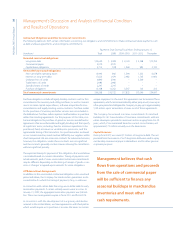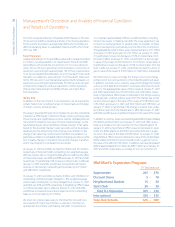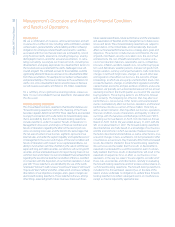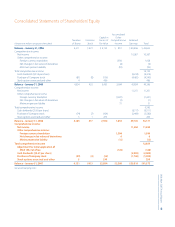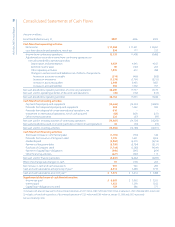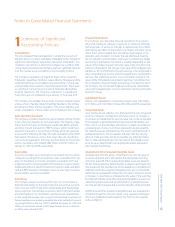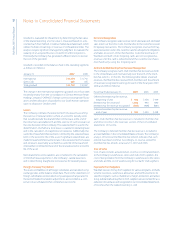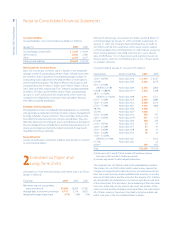Walmart 2007 Annual Report Download - page 39
Download and view the complete annual report
Please find page 39 of the 2007 Walmart annual report below. You can navigate through the pages in the report by either clicking on the pages listed below, or by using the keyword search tool below to find specific information within the annual report.
Wal-Mart 2007 Annual Report 37
Management’s Discussion and Analysis of Financial Condition
and Results of Operations
Japan. At January 31, 2007, a hypothetical 10% increase (or decrease)
in value of the U.S. dollar relative to the Japanese yen would result in a
gain (or loss) in the value of the debt of $103 million. At January 31,
2006, a hypothetical 10% increase (or decrease) in value of the U.S.
dollar relative to the Japanese yen would result in a gain (or loss) in
the value of the debt of $75 million.
Summary of Critical Accounting Policies
Management strives to report the nancial results of the Company in
a clear and understandable manner, although in some cases account-
ing and disclosure rules are complex and require us to use technical
terminology. In preparing our Consolidated Financial Statements, we
follow accounting principles generally accepted in the United States.
These principles require us to make certain estimates and apply judg-
ments that a ect our nancial position and results of operations as
re ected in our nancial statements. These judgments and estimates
are based on past events and expectations of future outcomes. Actual
results may di er from our estimates.
Management continually reviews its accounting policies, how they are
applied and how they are reported and disclosed in our nancial state-
ments. Following is a summary of our more signi cant accounting policies
and how they are applied in preparation of the nancial statements.
Inventories
We value our inventories at the lower of cost or market as determined
primarily by the retail method of accounting, using the last-in, rst-out
(“LIFO”) method for substantially all our Wal-Mart Stores segment’s
merchandise. Sam’s Club merchandise and merchandise in our distri-
bution warehouses are valued based on weighted-average cost using
the LIFO method. Inventories for international operations are primarily
valued by the retail method of accounting and are stated using the
rst-in, rst-out (“FIFO”) method.
Under the retail method, inventory is stated at cost, which is determined
by applying a cost-to-retail ratio to each merchandise grouping’s retail
value. The FIFO cost-to-retail ratio is based on the initial margin of the
scal year purchase activity. The cost-to-retail ratio for measuring any
LIFO reserves is based on the initial margin of the scal year purchase
activity less the impact of any markdowns. The retail method requires
management to make certain judgments and estimates that may
signi cantly impact the ending inventory valuation at cost as well as
the amount of gross margin recognized. Judgments made include
recording markdowns used to sell through inventory and shrinkage.
When management determines the salability of inventory has dimin-
ished, markdowns for clearance activity and the related cost impact
are recorded at the time the price change decision is made. Factors
considered in the determination of markdowns include current and
anticipated demand, customer preferences and age of merchandise,
as well as seasonal and fashion trends. Changes in weather patterns
and customer preferences related to fashion trends could cause material
changes in the amount and timing of markdowns from year to year.
When necessary, the Company records a LIFO provision for a quarter
for the estimated annual e ect of in ation, and these estimates are
adjusted to actual results determined at year-end. Our LIFO provision
is calculated based on inventory levels, markup rates and internally
generated retail price indices except for grocery items, for which we
use a consumer price index. At January 31, 2007 and 2006, our inven-
tories valued at LIFO approximated those inventories as if they were
valued at FIFO.
The Company provides for estimated inventory losses (“shrinkage”)
between physical inventory counts on the basis of a percentage of
sales. The provision is adjusted annually to re ect the historical trend
of the actual physical inventory count results. Historically, shrinkage
has not been volatile.
Impairment of Assets
We evaluate long-lived assets other than goodwill and assets with
inde nite lives for indicators of impairment whenever events or changes
in circumstances indicate their carrying values may not be recoverable.
Management’s judgments regarding the existence of impairment
indicators are based on market conditions and our operational per-
formance, such as operating income and cash ows. The evaluation
is performed at the lowest level of identi able cash ows, which is
generally at the individual store level or, in certain circumstances, at
the market group level. The variability of these factors depends on a
number of conditions, including uncertainty about future events and
changes in demographics, and thus our accounting estimates may
change from period to period. These factors could cause manage-
ment to conclude that impairment indicators exist and require that
impairment tests be performed, which could result in management
determining that the value of long-lived assets is impaired, resulting
in a writedown of the long-lived assets.
Goodwill and inde nite-lived other acquired intangible assets are not
amortized, but are evaluated for impairment annually or whenever
events or changes in circumstances indicate that the value of a certain
asset may be impaired. This evaluation requires management to make
judgments relating to future cash ows, growth rates, and economic
and market conditions. These evaluations are based on determining
the fair value of a reporting unit or asset using a valuation method
such as discounted cash ow or a relative, market-based approach.
Historically, the Company has generated su cient returns to recover
the cost of goodwill and inde nite-lived other acquired intangible
assets. Because of the nature of the factors used in these tests, if dif-
ferent conditions occur in future periods, future operating results
could be materially impacted.
Income Taxes
The determination of our provision for income taxes requires signi cant
judgment, the use of estimates, and the interpretation and application
of complex tax laws. Signi cant judgment is required in assessing the
timing and amounts of deductible and taxable items. We establish
reserves when, despite our belief that our tax return positions are fully
supportable, we believe that certain positions may be successfully
challenged. When facts and circumstances change, we adjust these
reserves through our provision for income taxes. The Financial Accounting
Standards Board issued Interpretation No. 48, “Accounting for Uncertainty
in Income Taxes,” which will require us to adjust our past methods of
judgment in assessing the timing and amounts of deductible and
taxable items commencing scal year 2008.





